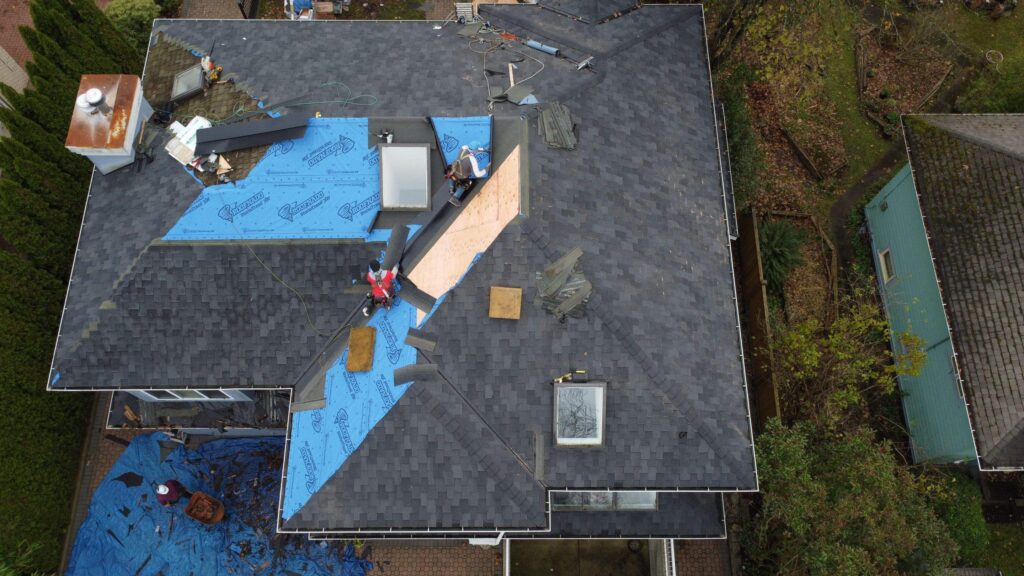Your roof starts leaking in the middle of the night. Rain is pouring in, and you can’t get a contractor out until next week. What do you do?
In situations like this, a roof tarp can be your home’s first line of defense. Designed as a temporary covering, it keeps your home dry, prevents costly interior damage, and gives you precious time to plan your next step. Whether you’re waiting on insurance or a contractor, the roof tarp gives you the protection you need—right when you need it.
In this blog, we’ll explore why tarping matters, when to use it, and how it plays a vital role in every emergency roof repair situation.
What Is a Roof Tarp and Why It Matters in a Roofing Emergency
A roof tarp is a durable, waterproof sheet used to temporarily cover damaged areas of your roof. It helps prevent further leaks, mold growth, and insulation damage.
Roofing emergencies are more common than people think. Strong winds, heavy rain, or falling tree branches can rip off shingles or punch holes through your roof. Delaying a proper roof fix in these moments can lead to severe structural issues and even health hazards caused by mold or water damage.
In fact, according to Environment and Climate Change Canada, extreme weather events have become more frequent, with high winds and storms causing increasing property damage each year.
When to Use a Roof Tarp for a Quick and Effective Roof Fix
Here are a few situations where a roof tarp is not just helpful—it’s essential:
- After a storm damages shingles or causes water infiltration
- During ongoing leaks that can’t be fixed immediately
- While waiting for an insurance claim or a contractor to inspect the damage
- If debris punctures your roof, such as fallen tree limbs or flying objects
These are critical times when you need a fast and secure way to prevent further problems. Installing a roof tarp can stop water from soaking your attic insulation, drywall, and electrical systems.
Even a small leak, when left untreated, can weaken structural beams and increase your overall cost of repairing roof components.
How a Roof Tarp Helps Minimize Damage
Temporary or not, a roof tarp can offer a surprising amount of protection. Here’s how it helps:
- Prevents water damage to ceilings, walls, and floors
- Reduces the risk of mold and mildew, which can develop in just 24 to 48 hours
- Protects your home’s insulation, maintaining energy efficiency
- Shields structural elements, like rafters and joists, from long-term decay
- Keeps indoor spaces safe from falling debris or pests entering through openings
When used properly, a roof tarp gives you breathing room during stressful situations—helping you avoid bigger repairs and costs later on.
Choosing the Right Roof Tarp for Your Home
Not all tarps are created equal. For a successful emergency solution, you need to select the right type:
- Material: Choose heavy-duty polyethylene or vinyl-coated tarps for weather resistance
- Waterproof and UV-resistant: A good roof tarp should repel water and withstand sun exposure
- Size: Make sure it extends at least 3–4 feet past the damaged area
- Reinforced grommets: These allow for better anchoring using ropes or nails
- Secure fastening: Use sandbags, nails, or wood strips to hold the tarp firmly in place
The National Roofing Contractors Association (NRCA) emphasizes the importance of fall prevention and proper safety measures when using tarps—especially during active weather or when working at heights.
Why Professional Help Matters in Emergency Roof Repair
When water starts dripping from the ceiling or shingles are missing after a storm, your first instinct might be to climb up and throw on a roof tarp yourself. And while that sounds like a quick fix, it often leads to more trouble than it’s worth. Without the right tools, training, or safety gear, even a small slip can cause serious injury—or worse, make the damage worse.
That’s where professionals come in. Certified roofers have the knowledge and experience to handle emergency roof repairs properly, even under pressure. Here’s why their help matters:
- They follow fall protection protocols as required by WorkSafeBC, ensuring that every move made on your roof is done safely.
- They know how to secure tarps correctly—without tearing shingles, damaging flashing, or leaving gaps that allow water to sneak in.
- They assess both visible and hidden damage. What looks like a small hole might reveal soaked insulation or structural issues beneath the surface.
- They ensure full compliance with building codes, insurance requirements, and safety standards, giving you peace of mind.
In emergency situations, cutting corners isn’t worth the risk. Hiring a professional means your roof fix will be handled quickly, safely, and with the right long-term plan in place. It’s not just about putting up a roof tarp—it’s about protecting your home from bigger problems down the road.
How to Find Help Fast for Roof Tarp Installation
If you’re in urgent need of help, acting quickly is crucial. Here’s what you can do:
- Call a local roofing company that offers 24/7 emergency response
- Ask if they provide temporary tarping services
- Be ready to describe the type of damage and its location
- Request a clear breakdown of what the emergency service includes
While waiting for help to arrive, there are also a few things you can do to prevent the problem from getting worse. For instance, covering the leak from inside or safely using a tarp if the weather allows can slow water intrusion. If you’re unsure what steps you can take on your own, check out these 7 smart ways to temporarily fix a roof leak until a roofer arrives. These tips can help you protect your home while waiting for a full inspection or repair.
Remember, placing a roof tarp isn’t the final step—it’s a short-term measure while you schedule proper repairs with professionals.

Final Thoughts: A Roof Tarp Buys Time—But Don’t Delay Permanent Repairs
A roof tarp is an effective, affordable solution during emergencies. It protects your home, prevents further damage, and gives you time to get the help you need. But remember—it’s just a patch, not a cure.
Once the weather clears and professionals are available, don’t delay in scheduling full repairs. Long-term damage, like rot or mold, doesn’t wait.
If your roof’s been hit by a storm, act quickly. Whether you handle it yourself or call for help, putting up a roof tarp can save your home from greater harm—and give you peace of mind when it matters most.

